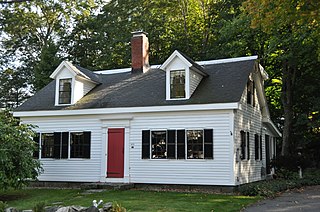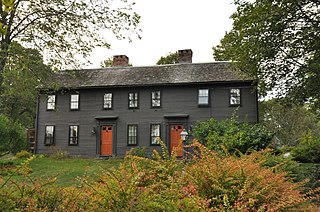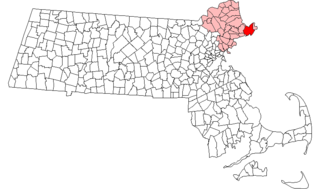
The Carroll–Hartshorn House is a historic First Period house at 572 Haverhill Street in Reading, Massachusetts. Built c. 1700, it is one of the oldest buildings in Reading, set on an early route between Wakefield and Haverhill. It has a classic two-story, five-bay, central-chimney plan, with a rear shed extension giving the house a saltbox appearance. Its windows, some still with original surrounds, are narrower and taller than typical for the period. The property was owned by generations of the Hartshorn family.

The Daniel Nichols Homestead is a historic home in Reading, Massachusetts. The oldest portion of this timber-frame house was built in the early 1740, with vernacular Georgian styling. The house is five bays wide and two deep, with a rear shed-roof extension giving the house a saltbox appearance. An ell was added in the mid-19th century. The main architectural detail is the front door surround, which features sidelight windows and recessed, paneled pilasters supporting a tall entablature.

The House at 483 Summer Avenue in Reading, Massachusetts, USA, is a modestly decorated vernacular Federal style cottage. The 1+1⁄2-story wood-frame house was built c. 1830, late for a Federal style building. Its significant Federal features are its five-bay facade, side-gable roof, and the door surround, which has pilasters supporting a tall entablature with a projecting cornice. The house is finished in wooden clapboards, and has two gabled dormers projecting from the front roof.

The House at 79–81 Salem Street, also known as the Samuel Allen House, in Reading, Massachusetts was a modest Greek Revival two-family cottage. The wood-frame house was built sometime between 1830 and 1854 was a typical vernacular Greek Revival house, with a five-bay facade and a paired central entrance. When the house was listed on the National Register of Historic Places in 1984, the two entrances were flanked by pilasters supporting an unusually tall entablature; the house was later covered in synthetic siding, and a projecting portion at the top of the entablature was removed. The structure was completely torn down in 2021 for new construction.

The Jabez Weston House is a historic house in Reading, Massachusetts. The older portion of this 2+1⁄2-story timber-frame house was built c. 1779 in a late-Georgian early-Federalist style. This portion consisted of a five bay section with a centrally located front door. Sometime, an eastern extension added three bays and a second entrance, converting the building into a two family residence. The property belonged to the Weston family, who were early settlers of the area.

The Richard Nichols House is a historic late First Period house at 483 Franklin Street in Reading, Massachusetts, United States. It is a 2+1⁄2-story wood-frame structure, six bays wide, with a side-gable roof, clapboard siding, rubblestone foundation, and an entry in the third bay from the left, with a chimney behind. The oldest portion of this house, probably a three-bay section with chimney, was built c. 1733, and expanded to five, and then six, bays later in the 18th century. The house, along with extensive landholdings, remained in the locally prominent Nichols family until the late 19th century.

The Timothy Hartshorn House is a historic house in Reading, Massachusetts. This 2+1⁄2-story wood-frame house was built c. 1787 by Timothy Hartshorn, a farmer and shoemaker, and remained in his family for over 100 years. It is a vernacular Georgian-Federal style, with five bays and a central chimney. The main entrance is flanked by sidelight windows and fluted pilasters, supporting an entablature with high capitals, but is somewhat obscured by the 19th century porch.

The Yale Avenue Historic District is a residential historic district near the center of Wakefield, Massachusetts. It encompasses eight residential properties, all but one of which were developed in the 1860s and 1870s, after the arrival of the railroad in town. These properties were built primarily for Boston businessmen, and mark the start of Wakefield's transition to a suburb.

The Parker House is a historic house at 52 Salem Street in Reading, Massachusetts. It is a 2+1⁄2-story vernacular Federal-style wood-frame house, five bays wide, with a side gable roof, clapboard siding, and a granite foundation. Its center entrance is particularly fine, with tall sidelight windows flanked by pilasters, and topped by an entablature with a shallow hood. The house was built in 1792, although its center chimney may date from an older house built on the site in 1715. Jonas Parker, the builder, was active in the American Revolution. A portion of Parker's farm was dedicated as Memorial Park in 1919.

The William Griffin Fuller House is a historic house at 32 Franklin Street in Stoneham, Massachusetts. The two-story wood-frame house was built c. 1850 for William Griffin Fuller, a real estate developer and trustee of the Stoneham Five Cent Savings Bank. Its features are transitional, including both Greek Revival and Italianate details. The five-bay facade and single-story porch are Greek Revival, and the bracketing in the eaves and gable ends is Italianate in style.

The House at 6 S. Marble Street in Stoneham, Massachusetts, is a rare early 19th century worker's house, and the only significant survivor of the early quarrying industry in Stoneham. It is a wood-frame house, two stories high, five bays wide and one room deep, with a side gable roof and a granite foundation. It has simple cornerboards and door and window trim. Houses like this were somewhat common on the early routes through the town, of which South Marble Street is a relatively undisturbed surviving fragment. This house was built about 1810.

The Micah Williams House is a historic house at 342 William Street in Stoneham, Massachusetts. The 1+1⁄2-story Greek Revival cottage was built c. 1830 by Micah Williams. Unlike many Greek Revival buildings, which have the gable end facing the street, this one has the front on the roof side, a more traditional colonial orientation. Its facade is five bays wide, with a center entrance sheltered by a hip-roof portico with square columns. The house was built by Williams for his daughter.

The Elias Boardman House is a historic house at 34 Salem Street in Wakefield, Massachusetts. Built in 1790, it is one of the city's most elaborate examples of Federal period architecture. It was built by Elias Boardman, and was dubbed Boardman's Folly for its extravagance. It was listed on the National Register of Historic Places in 1989.

The Nathaniel Cowdry House is a historic house at 71 Prospect Street in Wakefield, Massachusetts. Built about 1764, it is one of Wakefield's oldest buildings, built by a member of the locally prominent Cowdry family, who were early settlers. The house was listed on the National Register of Historic Places in 1989.

28 Cordis Street is a historic house located in Wakefield, Massachusetts. It is significant as a well-preserved example of the Greek Revival style houses built during the early to mid 19th century.

The House at 196 Main Street is a historic house located at 196 Main Street in Wakefield, Massachusetts.

The House at 28 Wiley Street in Wakefield, Massachusetts is an unusual Federal or Georgian style house. It is built of brick, a rare construction material in pre-Revolutionary Wakefield. It appears to have been built as an addition to another house, which has since been destroyed. Built into a hill, it presents 1.5 stories in front, and 2.5 stories in back. It has a tradition five bay main facade with a central door, which was embellished with a Federal style surround sometime after its initial construction. The house was probably built for a member of the Wiley family.

The House at 1 Woodcrest Drive in Wakefield, Massachusetts is a well-preserved late 18th-century Federal-style house. Built c. 1789, the 2+1⁄2-story timber-frame house has a typical five-bay front facade with center entry, and two interior chimneys. The doorway is framed by a surround with 3⁄4-length sidelight windows and flanking pilasters, topped by a modest entablature. It has two bake ovens, and its interior walls were originally insulated with corn cobs.

The Suell Winn House is a historic house at 72-74 Elm Street in Wakefield, Massachusetts. The house was built c. 1805 for Major Suell Winn, a local farmer, and is one of the best representatives of Federal-style architecture in Wakefield. It is a 2+1⁄2-story wood-frame structure, with two interior chimneys, a five-bay facade, and an elegant doorway with sidelight windows and an architrave. An ell extends the house to the right. Winn, a native of nearby Burlington, was killed crossing the railroad that divided his landholdings, after attending a town meeting where he protested the need for improved crossing signals at that location.

This is a list of the National Register of Historic Places listings in Gloucester, Massachusetts.























